
About UsThe Numismatic Bibliomania Society is a non-profit organization promoting numismatic literature. For more information please see our web site at coinbooks.org SubscriptionsThose wishing to become new E-Sylum subscribers (or wishing to Unsubscribe) can go to the following web page link MembershipThere is a membership application available on the web site Membership Application To join, print the application and return it with your check to the address printed on the application. Membership is only $20 to addresses in the U.S., $25 for First Class mail, and $30 elsewhere. For those without web access, write to: David M. Sundman, Treasurer
AsylumFor Asylum mailing address changes and other membership questions, contact David at this email address: dsundman@LittletonCoin.com SubmissionsTo submit items for publication in The E-Sylum, just Reply to this message, or write to the Editor at this address: whomren@gmail.com BUY THE BOOK BEFORE THE COIN |
- WAYNE'S WORDS: THE E-SYLUM SEPTEMBER 28, 2014
- THE ASYLUM WINS ANA OUTSTANDING CLUB PUBLICATION AWARD
- SKLOW MAIL BID SALE #23 CLOSES OCTOBER 11, 2014
- NEW BOOK: PLEASURE AND PROFIT
- QUERY: NUMISMATIC LITERATURE SALE INDEX
- INTERVIEW WITH NUMISMATOURIST HOWARD BERLIN
- BOB EVANS TO SPEAK AT OCTOBER 2014 PAN SHOW
- WHERE COINS DISAPPEARED TO IN THE CIVIL WAR
- STACK'S BOWERS TO SELL COLONIAL AND CIVIL WAR RARITIES
- ANSWER: WHO HAD ALL VARIETIES OF 1793 CENTS?
- NOTES FROM E-SYLUM READERS: SEPTEMBER 28, 2014
- THE JOSEPH C. MITCHELSON COLLECTION
- ANSWER: SAMUEL JOHNSON'S GOLD TOUCH PIECE
- MORE ON OCR AND NON-LINEAR LEGEND ORIENTATIONS
- 2012 OLYMPIC GOLD MEDAL COMES TO MARKET
- THE MARKET FOR OLYMPIC MEDALS
- AMERICAN MEDAL OF THE YEAR NOMINATIONS
- FIDEM 2014, SOFIA BULGARIA
- THE MUSEUM OF AMERICAN FINANCE
- COAL DOLLARS
- MORE STICKERED COINS
- SCULPTOR ANNA COLEMAN LADD
- JEFF GARRETT ON TECHNOLOGY AND NUMISMATICS
- ARTICLE PROFILES WILL NIPPER
- ARTICLE PROFILES RICHARD BAGG
- LORD ASHCROFT BUYS SGT. MAJOR GARVIN MEDALS
- ARTICLE PROFILES “THE EMPEROR OF THESE UNITED STATES”
- THE COINS OF ANCIENT SPARTA
- THE SEATON DOWN HOARD OF 22,000 ROMAN COINS
- GRASPABLE TESTIMONIES: GNADENPFENNIGE
- THE MARSHALL COLLECTION OF CONDER TOKENS
- INTERMARRIAGE PROTEST ENSNARES ISRAELI BANKNOTE
- FEATURED WEB SITE: AMERICAN MEDALLIC SCULPTURE ASSOCIATION
Click here to access the complete archive
To comment or submit articles, reply to whomren@gmail.com
WAYNE'S WORDS: THE E-SYLUM SEPTEMBER 28, 2014

I'm sad - no new subscribers this week. However, we do have 1,772 current email subscribers. Which of your numismatic friends is missing out? Sign them up for The E-Sylum.
This week we open with an award for The Asylum, a reminder from David Sklow, and one new book. Other topics include where coins disappeared to in the Civil War, Olympic medals, Coal dollars, Riddell's Confederate Half Dollar, the coins of Sparta, Tristram Dalton, Will Nipper, Rick Bagg, the Museum of American Finance and FIDEM XXXIII.
To learn more about Anna Coleman Ladd, the Joseph Mitchelson collection, Samuel Johnson's touch piece, the great King of the Bullion Dealers, stickered coins and gnadenpfennige, read on. Have a great week, everyone!
Wayne Homren
Editor, The E-Sylum
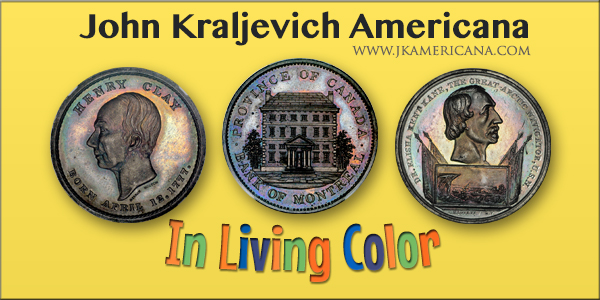
THE ASYLUM WINS ANA OUTSTANDING CLUB PUBLICATION AWARD
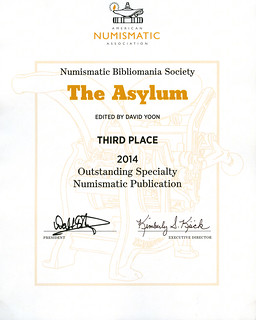 David Sundman reported that our print publication The
Asylum received a third-place award in this year’s ANA Outstanding Club Publications Award
competition. Congratulations to editor David Yoon and our excellent contributing writers.
-Editor
David Sundman reported that our print publication The
Asylum received a third-place award in this year’s ANA Outstanding Club Publications Award
competition. Congratulations to editor David Yoon and our excellent contributing writers.
-EditorFor a membership form, see:
http://www.coinbooks.org/about/NBS_Membership_Form_2014.pdf
SKLOW MAIL BID SALE #23 CLOSES OCTOBER 11, 2014
Numismatic Literature Sale # 23 is a mere two weeks away, closing Saturday October 11 at 8 PM.
Do not forget to submit your bids in our largest and most diversified auction sale to date!
Bids are accepted via US Mail, Email, Phone & Fax, up to and including closing day.
Below are some highlights: Enjoy!
- Scarce 1987 Special Edition RedBook
- Silver Dollars & Trade Dollars of the U.S. by Q. David Bowers, 2 Volume Set
- Continental Paper Money, 1866 by Henry Phillips
- Large offering of works concerning Medals & Tokens
- Original Documents bearing the signature of the Secretary of the Treasury, 1821, 1836, 1849, 1917 and 1953
- Early Coins of America, 1875 by Crosby
- Colonial Currency Reprints 1910-1911 original 4 volumes by Andrew Davis McFarland
- U.S. Copper Cents 1816-1957, Deluxe Full Leather Thick Paper by Newcomb
- U.S. Copper Cents 1816-1957, Deluxe Full Leather Thin Paper by Newcomb
- Complete Set of the Asylum 1980-2012
- Limited Numbered Edition Full Leather RedBook, 2008 Special ANS Edition
- The Shekel, Volumes 1-32 Complete, bound, 1968-1999
- Deluxe Leather Limited Numbered Edition 13 of 25, American Numismatic Biographies by Pete Smith
- Nice Offering of 19th Century Haseltine Auction Catalogs
- Deluxe Bound Numbered 3 volumes of the John Jay Pittman Collection by Akers
- Nice Offering of Works Concerning Counterfeiting
- Extremely RARE 1941 Silver Proof ANA Convention Medal in Presentation Case, to the Director of the Mint, Nellie Tayloe Ross
- Nice Offering of Early & Late ANA Badges & Medals
- Nice Run of Works by Elmore Jones Concerning English Coinage
- An Amazing Offering of the Canadian Antiquarian and Numismatic Journal 1872-1933, by Individual Volumes & Issues
- Description Historique Des Monnaies Frappees Sous L'Empire Romain Communement Appelees Medailles Imperiales, 7 volume set 1859-1868, by Henry Cohen, Ex: William Sumner Appleton Library
- Financing An Empire: History of Banking in California, Deluxe Edition, 1927, 4 volume set by Ira B. Cross
- Fabulous Signed Letter from Farran Zerbe on Lewis & Clarke Centennial Exposition Letterhead
- RARE 1912 ANA Membership Card, issued to Canadian Member Andrew Browning Baird
- Rarities of Numismata Typographica: Four Examples of Early Dutch Printers' Bookbinders' & Booksellers' Guild Medals: Cast in Sterling Silver, 1996, Bird & Bull Press Numbered Limited Edition 28 of 120, Book and Medals in Slipcase
- Scarce ANA Executive Director's Survival Medal
- 1925 Original Early Quarter Dollars of the U.S. by A.W. Browning
- Numisma - New Netherlands Coin Co. 1954-1960 Complete
- Complete Set of the Asylum 1980-2013
- History of The Bureau of Engraving and Printing, 1964, The BEP's Own Copy No. 2
- Long Run of Barney Bluestone Auction Catalogs
- Very Long Run of M.H. Bolender Auction Catalogs
- Plated Henry Chapman Catalog of the Matthew Stickney Sale
- Plated Henry Chapman Catalog of the C.A. Baldwin Sale
- Extremely Rare Plated S.H. Chapman Catalog of the Charles Gordon Zug Sale
- Plated S.H. Chapman Catalog of the Major Richard Lambert Sale
- Plated S.H. Chapman Catalog of the Julius L. Brown Sale
- Plated S.H. Chapman Catalog of the Sterling P. Grove Sale
- Long Run of Henry Chapman Auction Sales, Many Scarce Small Size in Cloth
- Long Run of S.H. Chapman Auction Sales
- Nice Offering of Early Redbooks and Bluebooks by Yeoman
- RARE ANA Membership Directories
- RARE Early Issues of The Numismatist 1892 & 1893
- Long Run of the Numismatist 1894-1919 Offered by Individual Volumes
- Long Run of the Numismatist 1920-2013 as one lot
- Scarce Hardbound Editions of Heritage Auction Catalogs
- Scarce Hardbound Editions of Steve Ivy Auction Catalogs
- Nice Offering of Deluxe Stacks Auction Catalogs
- Run of Deluxe Ford Sale Catalogs
- Nice Offering of Deluxe Superior Auction Catalogs
- A Complete Run of Morgenthau Auction Catalogs
- Nice Run of Wayte Raymond Auction Catalogs
- Much, Much More!!!!!!!
David Sklow-Fine Numismatic Books
P.O. Box 6321
Colorado Springs, CO 80934
PH: 719-302-5686
FAX: 719-302-4933
Email: numismaticbooks@aol.com
Web Site: FineNumismaticBooks.com
NEW BOOK: PLEASURE AND PROFIT
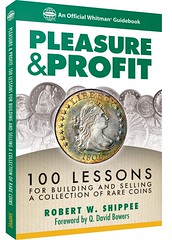 Whitman Publishing announces the release of
Pleasure and Profit: 100 Lessons for Building and Selling a Collection of Rare Coins, by
Robert W. Shippee. The 320-page book will debut November 11 for the 2014 holiday season. Before
then it can be pre-ordered from booksellers and hobby shops nationwide, and online (including at
Whitman.com), for $9.95 retail. The book can also be borrowed for free as a benefit of membership
in the American Numismatic Association, through the Dwight N. Manley Numismatic Library.
Whitman Publishing announces the release of
Pleasure and Profit: 100 Lessons for Building and Selling a Collection of Rare Coins, by
Robert W. Shippee. The 320-page book will debut November 11 for the 2014 holiday season. Before
then it can be pre-ordered from booksellers and hobby shops nationwide, and online (including at
Whitman.com), for $9.95 retail. The book can also be borrowed for free as a benefit of membership
in the American Numismatic Association, through the Dwight N. Manley Numismatic Library.
In Pleasure and Profit, longtime collector and retired international banker Robert Shippee reveals how he got serious about building a type collection of rare coins, carefully assembled the Waccabuc Collection of half cents through $20 gold double eagles, and later sold them at public auction. Shippee tells the story “warts and all”—sharing not only his highly profitable purchases, but also the duds and costly mistakes. He analyzes each purchase of 100-plus copper, nickel, silver, and gold coins, capping each analysis with a valuable lesson learned. His story ends with a $1.5 million sale at public auction.
Shippee supplements his real-world advice on acquisition strategies, storage choices, and disposition options with commentary on grading services, auction houses, famous dealers, numismatic personalities, market forces, and—with candor that’s rare these days—his laid-bare financial results. His insight is humorous, wise, and unflinching . . . uniquely valuable for today’s collector and investor.
A chapter on “Finances—The Final Scorecard” compares rare coins to stocks, with an analysis of different indexes. Shippee breaks down the biggest losers and the biggest winners in his basket of coins, and looks at the results by denomination, by century, by metallic composition, by grade, and by holding period.
“Bob Shippee shares his advice with a relaxed storyteller’s wit,” says Whitman publisher Dennis Tucker. “His text is about coins, but it’s also about golf, whisky, friendships, and other good things in life that are attached to his experience as a collector. His storytelling makes the lessons fun and interesting.”
Q. David Bowers, who wrote the book’s foreword, says, “Pleasure and Profit is one of the most useful books in American numismatics. It will change your buying strategies.”
Pleasure and Profit: 100 Lessons for Building and Selling a Collection of Rare Coins
By Robert W. Shippee; foreword by Q. David Bowers I
SBN 0794842437
Softcover, 6 x 9 inches, 320 pages, Full color
Retail $9.95 U.S.
https://www.whitman.com/store/Inventory/Detail/Pleasure--Profit--100-Lessons-for-Building-and-Selling-a-Collection-of-Rare-Coins+0794842437
QUERY: NUMISMATIC LITERATURE SALE INDEX
First, as this is my first email to you, let me take the opportunity to thank you for your efforts for the NBS and The E-Sylum in particular. With numismatic literature, I think I have found my "home" in the hobby. I joined NBS early this year and am enjoying it tremendously.
I have a question on which the E-Sylum readers might be able to assist.
I am wondering if there are any indices or compilations of the various numismatic literature auctions of the last few decades (listing by author and title, then listed by auction and lot with additional details per lot as needed). I know Charles Davis' American Numismatic Literature has many listings for past sales, but it necessarily does not list every lot and of course is over 20 years old so misses many new listings.
Such indices would be very helpful for literature researchers, I think.
If no such indices exist for the catalogs, I am considering compiling them myself. I was considering starting with The Money Tree auctions (about 25,000 lots). I just wanted to check to see if anyone else is working on such a thing (so as not to duplicate effort), if such references do not already exist.
THE BOOK BAZARRE
INTERVIEW WITH NUMISMATOURIST HOWARD BERLIN

Imagine traveling the world and going in all the great numismatic museums. That is just what Howard Berlin has done and he has written a book describing the different collections.
This new book will inspire you to travel and learn more about numismatics.
To watch the video, see:
The Numismatourist Book Describes Numismatic Museums Around the World. VIDEO: 3:18
(www.coinweek.com/coins/coin-supplies/books-2/numismatourist-book-describes-numismatic-museums-around-world-video-318/)
To read an earlier E-Sylum article, see:
NEW BOOK: THE NUMISMATOURIST
(www.coinbooks.org/esylum_v17n31a03.html)
BOB EVANS TO SPEAK AT OCTOBER 2014 PAN SHOW
PAN has a very knowledgeable visitor coming to our event. Mr. Bob Evans, the Chief Scientist and Historian of the S.S. Central America Project, and the Co-Discoverer of the shipwreck site will be part of our PAN Lecture Series and will give a presentation. Bob has just returned to dry land from a summer out at the salvage site and says, “There is a lot of very meaty numismatic material to cover, since the treasure recovered this past season includes so much more in the way of smaller gold, the money belonging to the passengers, and the ship's money. We have an absolutely amazing numismatic time capsule now. We already had one before, from the 1988 - 1991 recoveries, but that was the money of banking and big business, a commercial shipment from San Francisco to New York. Now we have the people's treasure: small US gold, California fractional gold, foreign coins, silver dimes quarters and half dollars. The inventory has been published in Odyssey's monthly court reports, but I will bring it to life.”
Bob is very excited to share his experiences from this memorable summer with fellow numismatists and PAN is delighted to offer a perfect venue for those that are interested. His lecture is scheduled for 3:00 pm on Friday October 24th. This talk will cover the more technical numismatic side of the recovered coins. Bob will also be our keynote speaker at the PAN banquet at the Doubletree Hotel Ballroom. His topic will be similar to the afternoon numismatic lecture but will also cover some of the other artifacts belonging to the crew and passengers. Bob said, “My evening banquet talk will focus on some of this, but also on some really fun stuff, other artifacts, the "adventure" aspect and personal experiences, as well as some Pennsylvania angles.”
The Lecture Series is free and open to the public. The banquet is open to PAN members and non-members and guests. The banquet will be “A Night to Remember” if we may take the title from the old 1958 Titanic movie. So folks, get your sea legs ready, pull up your anchor, and make the voyage to the Monroeville Convention Center.
Monroeville is full of nice hotels. The Doubletree by Hilton is the official convention hotel. PAN has a room block with a special rate of $98 but it expires on October 1st. You will have to act quickly.
More info can be found on our website at www.PANcoins.org
WHERE COINS DISAPPEARED TO IN THE CIVIL WAR
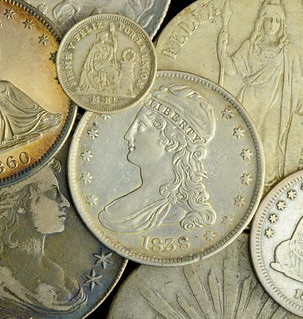 The impact of the American Civil War and the
fractional-currency era on silver coins is fairly clear. As author Neil Carothers related in
Fractional Money (1930), banks in the North suspended payment of gold (in exchange for their
bank notes at face value) at the end of December 1861. The first issue of greenbacks (which were
essentially IOUs issued by the federal government instead of a local bank) appeared in April 1862,
and immediately began to depreciate in terms of their face value in gold coin. The currency that
was worth 97 cents on the dollar in terms of gold at the beginning of May was worth only 95 cents
by mid-June and 92 cents by that month’s end.
The impact of the American Civil War and the
fractional-currency era on silver coins is fairly clear. As author Neil Carothers related in
Fractional Money (1930), banks in the North suspended payment of gold (in exchange for their
bank notes at face value) at the end of December 1861. The first issue of greenbacks (which were
essentially IOUs issued by the federal government instead of a local bank) appeared in April 1862,
and immediately began to depreciate in terms of their face value in gold coin. The currency that
was worth 97 cents on the dollar in terms of gold at the beginning of May was worth only 95 cents
by mid-June and 92 cents by that month’s end.
Silver coinage, which had been slowly disappearing from circulation, was by then completely absent from the channels of commerce. Everyday retail transactions were completed with a combination of cents and fractional scrip until federal fractional currency was introduced in Fall 1862.
[To learn more] I set out to study 19th-century periodicals, electronic versions of which are now freely available on a number of websites. My efforts were rewarded by James Parton’s profile of the Gorham Manufacturing Company in the September 1868 issue of Harper’s New Monthly Magazine. In addition to a history of the demand for silver spoons in New England and an explanation of how sterling (.925 fine) became the standard for American silverware, the text offered much to satisfy a numismatic researcher. The numismatically relevant portions of the article are excerpted here.
…Generally, however, it is to Wall Street or its vicinity that the makers of silver-ware resort for their daily supply of the precious metals. In these times, when the price of gold and silver changes every minute or two, and sometimes more than once in a minute, no one buys a large quantity in advance. There are often in course of treatment, in the various apartments of the Gorham factory, as much as three tons of silver; but it is only necessary to start one or two thousand ounces every morning on their progress through the establishment in order to keep every department in full activity.
The time has been when silversmiths could not buy in all New York five hundred dollars’ worth of silver, and they had to run about Chatham Street hunting up little lots of dimes and half-dimes that used to be displayed in the windows of lottery shops.
These bullion and coin dépôts in Wall Street are interesting to the unaccustomed visitor. There is something respectable, if not impressive, about a long row of large, smooth kegs of Mexican or Peruvian dollars rough from the mint. …Most interesting of all is it to see great heaps of the small silver coin of the country, long lost to sight, to memory dear. I ventured to ask the great King of the Bullion Dealers—one of those mighty men who buy half a million of gold with a wink, and sell it again with a nod—I say I took courage to ask this potentate what had become of all the small silver coin which we used to have in circulation, but which children six years of age have never seen. “Where,” said I, “are the dimes and half-dimes and quarters at this moment? The silver-smiths melt only dollars and half dollars. Where, then, have the small coins gone?” He replied that a large quantity of them had found their way to Canada; more still to the West Indies and South America; but that there is still a large amount of it in this country, performing the office of a savings-bank to ignorant and timid people. A proof of this is that parcels of it frequently come into “the street” from distant points. I saw, myself, that day ten thousand dollars’ worth in one heap, which had just arrived from the country, and was about to be shipped to Havana, where it would then be used to advantage.
This article illustrates the great advantage of reading contemporary sources: the time period is brought to life in a way that no secondary source can match, and it includes details that might have been overlooked or not thought relevant by subsequent researchers. In just a few pages, I learned not only where many American silver coins went during the Civil War, but also gained some insight about how many of them might have disappeared into silversmiths’ melting pots across the country; how much of a problem contemporary counterfeit coins presented; and how they were detected and destroyed.
STACK'S BOWERS TO SELL COLONIAL AND CIVIL WAR RARITIES
For many decades, a private collector quietly assembled one of the finest collections of American colonial coins ever formed. Capably facilitated by legendary dealer Lester Merkin, and ably assisted by the Stack family, the collection grew to include over 120 pieces of Massachusetts silver, outpacing the Boyd-Ford Collection to become the most complete grouping ever offered. The collection is now sold on behalf and under the name of the Henry P. Kendall Foundation, an American philanthropic enterprise that has been focused on environmental issues for more than fifty years.

Undated (1652) NE Shilling. Noe II-A, Salmon 2-B. Rarity-7. Ex: Winsor.
The heart of the Collection is the early American coinage, led by the foremost assemblage of Massachusetts silver coins ever brought together for auction. Six different NE shillings, along with the Crosby Plate (1875) - Bushnell (1882) - Garrett Collection NE Sixpence, leaves the Collection complete by die variety among NE pieces, aside from the unique NE threepence permanently impounded in the Massachusetts Historical Society. The Willow Tree pieces are also practically complete, with five of the six known shilling varieties, a superb Willow Tree sixpence, and the only Willow Tree threepence in private hands. More than 50 examples of the Oak Tree type are included, led by the unique Noe-15 Oak Tree sixpence, called a “pattern” by Noe. A similar number of Pine Tree coins will be offered, including high grade pieces, extremely rare varieties, and coins with legendary pedigrees.

1652 Oak Tree Sixpence. Noe-15. Unique. Struck over Cut Down Oak Tree Shilling.
Ex Bushnell-Stickney. Noe Plate.
Other colonial and early American coins accompany the Massachusetts silver, including the Crosby plate examples of both the Maryland Lord Baltimore groat and the Standish Barry threepence, an extremely rare God Preserve New England Elephant token, a landmark 1670 Gloriam Regni 15 sols of Nouvelle France, and five Sommers Island coins, representing each denomination, twopence through shilling. 1787 New York Excelsior coppers were collected in detail, featuring very rare Standing Indian and George Clinton coppers.

1792 Birch Cent. Judd-4, Pollock-5. Rarity-7-. Copper.
Lettered Edge: TO BE ESTEEMED * BE USEFUL. Ex: Bushnell-Parmelee-Jenks-Col. Green.
This magnificent collection’s many post-Colonial rarities are led by several rare 1792 patterns. The highlight is undoubtedly the choice 1792 Birch cent acquired privately in 1975 from Stack’s and the finest example offered since the 1979 Garrett I sale. A 1792 silver center cent, one of fewer than 15 known, showcases a design conceived by Thomas Jefferson and was among the first pieces struck at the Philadelphia Mint. Examples of the 1792 disme in copper and the 1792 half disme will also be offered.
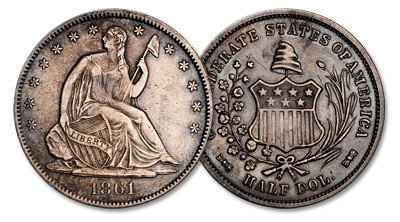
1861 Confederate Half Dollar. Original. Breen-8000.
The Riddell Specimen. One Of Only 4 Known.
An abiding interest in the history of the American South also inspired a focus on the coinage of the Confederacy. The 1861 Confederate States of America half dollar, one of just four original examples struck, will be sold publicly for the first time after having been a part of the Cabinet since its acquisition from Lester Merkin in 1971. A rare original 1861 Confederate States of America cent will also be offered, along with ca. 1874 restrikes by John Haseltine. These Confederate rarities are counterbalanced by three examples of the extremely rare Union 1864 Colored Troops Army of the James medal, commissioned by General Benjamin Butler to be awarded to African-American soldiers distinguished by their bravery in the attack on Newmarket Heights.
Mostly assembled from the late 1950s through the 1990s, with a few notable additions within the last 15 years, the Collection features many coins with famous provenances, including pedigrees to Bushnell, Parmelee, Winsor, Stickney, Jenks, Stearns, Groves, Garrett, Roper, Ford and more. Coins from the Collection have served as plate coins in Crosby’s Early Coins of America (1875), Noe’s monographs on Massachusetts silver, Breen’s Encyclopedia, and other standard references. Many others have not been offered publicly in a century, if ever.
The collection will be offered at public auction in Baltimore, Maryland, as part of Stack’s Bowers Galleries Official Auction of the Whitman Coin & Collectibles Expo in March 2015. Printed catalogs will be available prior to the sale and the Collection, along with the entire Stack’s Bowers Galleries March 2015 auction, will be available for viewing and bidding at StacksBowers.com.
To read the complete press release, see:
Stack’s
Bowers Galleries Announces Historic Sale of World-Class Collection of Massachusetts Silver,
Colonial and Early Federal Coins, and Issues of the War Between the States
(media.stacksbowers.com/SBG_eblast_images/2014/SBG-Kendall-Coll-PR-eblast-092214.html)

ANSWER: WHO HAD ALL VARIETIES OF 1793 CENTS?
Last week Jim Neiswinter asked:
Who was the only person ever to complete a collection (100%) of all the varieties of 1793 cents?
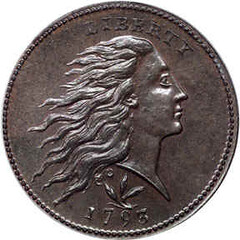 In the last issue of The E-Sylum, Jim
Neiswinter asked “Who was the only person ever to complete a collection (100%) of all the varieties
of 1793 cents?” My initial reaction is that no one ever had them all. The unique 1793 NC-5 was
donated to the ANS in 1946 and the NC-6 was not discovered until about 1978. In discussion with
Jim, he clarified that he was looking for a collection that was 100% complete according to the
currently known varieties.
In the last issue of The E-Sylum, Jim
Neiswinter asked “Who was the only person ever to complete a collection (100%) of all the varieties
of 1793 cents?” My initial reaction is that no one ever had them all. The unique 1793 NC-5 was
donated to the ANS in 1946 and the NC-6 was not discovered until about 1978. In discussion with
Jim, he clarified that he was looking for a collection that was 100% complete according to the
currently known varieties.
The Dr. Thomas Hall collection was cataloged by Frossard number. In his inventory he did not list Frossard 6 which is now believed to be the same as Frossard 7. He also did not have Frossard 13 with the second reverse (S-15). He had only one edge variety for Frossard 9 (S-11a) His inventory also included new cents discovered after the publication of Frossard.
When Sylvester Sage Crosby wrote his description of the cents of 1793, he relied heavily on the collection of Hall. He described 21 different varieties. Although he mentioned two edge varieties of 11-J, he did not assign them different numbers. By 1897, Hall’s collection included all the known 1793 varieties with the exception of 12-K, the variety now known as S-15. Hall died in May of 1909, and his collection was acquired by Virgil Brand on September 7, 1909.
On May 25, 1919, Brand acquired the collection of Carl Wutzbach including his 1793 12-K (S-15). Wurtzback also had two edge varieties of Crosby 11-J (S-11a and S-11b) Wurtzback was missing the NC varieties. This then gave Brand the complete collection to meet the requirement of the Neiswinter challenge. However, Brand did not have one of the edge varieties or the NC-6 that had not yet been discovered. Thus Brand’s collection is considered complete but had one coin fewer than Dan Holmes.
Virgil Brand died in 1926 and his estate passed to his son Armin. On February 7, 1941, Armin consigned a group of 17 condition census 1793 cents to St. Louis dealer Burdette G. Johnson. The group included all five known varieties that Dr. Sheldon would later designate as “non’collectible.”
In describing the varieties of the cents of 1793, Dr. Sheldon gave numbers to the varieties of S-1 through S-16. There were two additional edge varieties of S-11 and five varieties with NC numbers NC-1 through NC-5. That made 23 different varieties. A new variety, NC-6, was discovered about 1978.
Dan Holmes acquired a set of 1793 cents that included all the varieties except the unique NC-5 that was impounded in the ANS collection. The collections of Hall and Holmes were remarkable for being assembled one coin at a time. Brand, on the other hand, just bought up large collections.
I also teased Jim that he should include Tristram Dalton. Dalton was the Mint Treasurer who received all struck coins from the coiners. Thus he really had 100% of the 1793 cents.
Jim writes:
Virgil Brand is the correct answer. He completed the set of all known 1793 varieties in just two purchases. The first was from Dr. Thomas Hall in 1909. Hall owned every variety of 1793, including all NCs known (5) at that time, except for the C14K (S15). Ten years later Brand purchased a set of large cents from Carl Wurtzbach (Brand's cousin). Among this group was the ninth finest C14K. So Brand's set of 1793 varieties was 100% complete. The NC6 was not discovered until 1977. The Dan Holmes collection lacked only the unique NC5 that is in the ANS collection.
I'm impressed by the time put in by Pete in finding the answer. The only critique I have is that by 1897 two new obverses ( NC1 & S7 ) had been discovered sine the 1869 AJN article on the Types and Varieties of U. S. Cent, 1793`. So the 12k was now the 14K. I'd really be impressed if anyone else (besides maybe Joel Orosz or Dave Bowers) knew who Tristram Dalton was.
To read the earlier E-Sylum article, see:
QUIZ: WHO HAD ALL VARIETIES OF 1793
CENTS? (www.coinbooks.org/esylum_v17n39a21.html)
NOTES FROM E-SYLUM READERS: SEPTEMBER 28, 2014
New Books: Additional Images

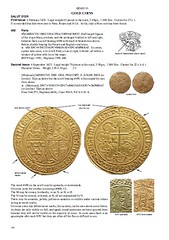
To read the earlier E-Sylum articles, see:
NEW BOOK: AUTHORITATIVE REFERENCE ON
LIBERTY SEATED HALF DIMES (www.coinbooks.org/esylum_v17n29a06.html)
NEW BOOK: A CATALOGUE OF ANGLO-GALLIC
COINS (www.coinbooks.org/esylum_v17n39a03.html)
Notes on Medals From Scott Miller
Scott Miller writes:
As for the Treaty of Versailles medal by Chester Beach, the serpent signifying the losing side of the war was described in the original circular for the medal as the “fallen figure of destruction, whose torch is being trampled beneath the foot of Justice”.
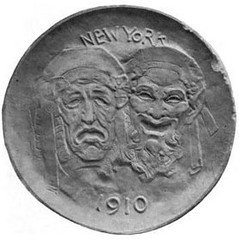 With regard to the Actors Fund medal, the two
comic heads on the obverse are more properly Comedy and Tragedy masks.
With regard to the Actors Fund medal, the two
comic heads on the obverse are more properly Comedy and Tragedy masks.
Finally, the Tweet by John Quincy Adams referring to medals as monuments…of the Vanity of human greatness reminded me of the resolution passed by the American Numismatic and Archaeological Society on April 27, 1865. As justification for authorizing a memorial medal for the late President Abraham Lincoln, the Society indicated that it was “the duty of this Society to perpetuate the memorials of historic greatness”.
To read the earlier E-Sylum articles, see:
THE LIFE AND WORK OF CHESTER BEACH
(www.coinbooks.org/esylum_v17n39a22.html)
JOHN QUINCY ADAMS TWEETS FROM BEYOND THE
GRAVE (http://www.coinbooks.org/esylum_v17n39a17.html)
Notes on Medals From Scott Miller
David Schenkman writes:
Although this isn’t a coin, I was reminded of it when I read the comments on eccentric bimetallic coins in the last E-Sylum. It was issued for the 1904 Interstate Convention of Bituminous Coal Miners & Operators. The overall length is approximately 90mm, while the brass medal itself is 39mm. The four aluminum inserts are 13mm each; they depict the state seals of Indiana, Pennsylvania, Illinois, and Ohio.


To read the earlier E-Sylum article, see: NOTES FROM E-SYLUM READERS: SEPTEMBER 21, 2014 : More on Eccentric Bimetallic Coins (www.coinbooks.org/esylum_v17n39a10.html)
On Patent Publication
Steve Bishop writes:
As a patent professional, I have to take exception to the statement regarding the Journal of Numismatic Research and the patent to the coining press. Although the publication in the Journal may have extensive commentary, it is not the "first publication" of the entire patent. It was published in 1896 and has been available to the public ever since. In fact, if you want a copy of it, just go to www.freepatentsonline.com, and you can download a PDF copy (free registration is required),
To read the earlier E-Sylum article, see:
THE JOURNAL OF NUMISMATIC RESEARCH
(www.coinbooks.org/esylum_v17n39a08.html)
How the Taco Bell Dollar Got Damaged
Regarding the silver dollar seen in the Taco Bell commercial, Justin Perrault writes:
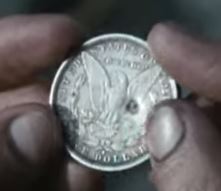 I agree, it would be interesting know
where the producers acquired this piece. As the story of the silver dollar is told in the
commercial, the grandfather's life was saved in the 1970's construction riots, when a nail
gun nail was deflected by the silver dollar in his pocket. That is the cause of the indentation on
the reverse of the coin.
I agree, it would be interesting know
where the producers acquired this piece. As the story of the silver dollar is told in the
commercial, the grandfather's life was saved in the 1970's construction riots, when a nail
gun nail was deflected by the silver dollar in his pocket. That is the cause of the indentation on
the reverse of the coin.
To read the earlier E-Sylum article, see:
NOTES FROM E-SYLUM READERS: SEPTEMBER 21,
2014 : The Taco Bell Silver Dollar (www.coinbooks.org/esylum_v17n39a10.html)
A 1962 Seattle World's Fair Dollar
Web site visitor Jeff Harrison writes:
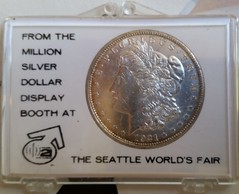 "I was going through my Grandfather's
coin collection and found a silver dollar from "The Million Silver Dollar " display booth
from the Seattle World's fair. I found your article and your request for an image."
"I was going through my Grandfather's
coin collection and found a silver dollar from "The Million Silver Dollar " display booth
from the Seattle World's fair. I found your article and your request for an image."
To read the earlier E-Sylum article, see:
MORE ON THE 1962 SEATTLE WORLD'S FAIR
MILLION SILVER DOLLAR EXHIBIT (www.coinbooks.org/esylum_v13n50a19.html)
Hitler and the Gold Kennedy Fiasco
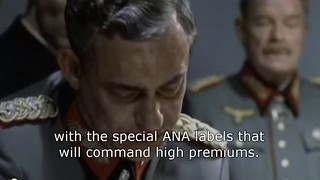 John Parker passed along this link to a funny video
about the recent Gold Kennedy half dollar sales fiasco. It's a movie clip with new dialogue
added. I've passed this along to some people privately, and everyone found it amusing. Check it
out. -Editor
John Parker passed along this link to a funny video
about the recent Gold Kennedy half dollar sales fiasco. It's a movie clip with new dialogue
added. I've passed this along to some people privately, and everyone found it amusing. Check it
out. -EditorTo watch the video, see:
Hitler Reacts to US Mint release of JFK gold
coin (www.youtube.com/watch?v=iIUto60ywG0)
More on Numismatic Toilet Seats
Bruce Perdue writes:
"I collect coins encased in plastic. Several years ago I exhibited parts of my collection at the CSNS Anniversary Convention. That exhibit included a toilet seat which has 13 dollar bills embedded in the lid and a wide variety of coins in the seat for those who like to sit on their money. These seats are available on eBay on a regular basis. The hinges tend to break away from the seat and lid when used."
Tony Terranova of New York City writes:
"Those toilet seats, along with various desk items, were made in the early 1970s . They were sold in NY city, specifically Abraham & Straus department store in Brooklyn. Come to think of it, it was the early 1960s when I first saw those Lucite encased coin items. I still have somewhere a 1963 proof set square paperweight."
To read the earlier E-Sylum article, see:
COIN-FILLED LUCITE TOILET SEAT
(www.coinbooks.org/esylum_v17n39a33.html)
THE JOSEPH C. MITCHELSON COLLECTION
Ron Guth writes:
I ran across a site that includes information relative to the Joseph C. Mitchelson collection in the Connecticut State Library. You'll have to search for Mitchelson's name to wade through the fluff. I found it interesting that the State of Connecticut passed an Act to add coins to the collection each year...my previous understanding was that Mitchelson set up a fund to do that. I wonder if Connecticut is continuing to add to the collection as they promised, though the $250 annual appropriation is no longer sufficient to purchase every coin type issued by the U.S. mints each year.
AN ACT CONCERNING THE JOSEPH C. MITCHELSON COLLECTION.
Be it enacted by the Senate and House of Representatives in General
Assembly convened:
The State Librarian is hereby directed to continue The Joseph C. Mitchelson Collection of coins, tokens, and medals by adding each year a proof specimen, or if not so coined, an uncirculated specimen of each variety of coin minted in the several mints of the United States. The comptroller, upon vouchers of the State Librarian, is hereby directed to draw his order on the Treasurer for such amount as may be necessary for the purposes of this act, not to exceed two hundred and fifty dollars annually.
Approved, June 2, 1913.
As it was Mr. Mitchelson's intention to have this collection serve as a permanent historical collection which shall easily and authoritatively show the evolution and development of our money, a separate coin box substantially made from cardboard and properly labeled with white lead has been provided for each known variety of each date and issue of the several mints, whether he had succeeded in securing a specimen of that variety or not. As a result there appear in the collection several empty boxes properly labeled, which will bear the legend, "Not yet in collection." By this method Mr. Mitchelson thought to show at a glance what, when and where the several coins of our country had been minted. Six sizes of boxes have been used in installing the collection. While we have been led to think of this collection of coins, bills, tokens and medals as being confined to America, it is interesting to note that there have been already classified coins from over one hundred and twenty foreign governments and municipalities.
To read the complete book, see:
www.archive.org/stream/budgetreportsta46contgoog/
budgetreportsta46contgoog_djvu.txt
THE BOOK BAZARRE
ANSWER: SAMUEL JOHNSON'S GOLD TOUCH PIECE
It's the birthday of Samuel Johnson (books by this author), born in Litchfield, England (1709). He was a sickly boy, and had been since the day he was born — "almost dead," he said. He contracted the lymphatic form of tuberculosis, called scrofula, when he was two, and because it was popularly believed that the touch of royalty could cure scrofula, he was taken to the queen. She touched him and gave him a gold medallion, which he kept for the rest of his life. Her touch didn't cure him, and neither did various disfiguring treatments that left him scarred.

Dr Johnson's touch-piece
English, AD 1711
For many centuries it was believed that the touch of a king or queen would cure an individual suffering from scrofula, a disease of the lymphatic system also known as the king's evil. Ceremonies at which British monarchs 'touched' sufferers continued from the time of Edward the Confessor (reigned 1042-66) to Queen Anne (reigned 1702-14).
By the sixteenth century 'touching' involved hanging a gold coin around the neck of the sufferer. The coin was usually an angel, a denomination introduced in 1464 and named after the figure of the archangel St Michael which appeared on it. After production of the coin had ceased in the mid-seventeenth century, small medals of a similar design were produced specifically for the ceremonies. The inscription that appears around the saint on these pieces translates as 'To God alone the glory', indicating the ultimate source of the cure. This example is said to be the medal with which Queen Anne 'touched' Samuel Johnson (1709-84) in 1711, when the future writer and compiler of the celebrated Dictionary of the English Language was a sickly two-year old baby.
To read the complete article, see:
Dr Johnson's touch-piece
(www.britishmuseum.org/explore/highlights/highlight_objects/cm/d/dr_johnsons_touch-piece.aspx)
Scott Miller writes:
I took a quick look in Helen Farquhar’s Royal Charities, and sure enough, in Part IV she devoted several pages to Dr. Johnson and noted “It appears that Johnson was himself no great believer in the royal gift of healing, and we know that he did not long wear the token presented by the Queen, for, as we see it in the British Museum, it is in fine condition”.
Andy Singer writes:
Samuel Johnson’s gold medallion, properly called a “touch piece”, is presently in the British Museum. Noel Woolf, in The Sovereign Remedy. Touch Pieces and the King’s Evil. The British Association of Numismatic Societies. Doris Stockwell Memorial Papers No. 4 (Manchester, 1990), writes on page 18:
“Among those Touched by Queen Anne was Dr. Johnson. He was brought to her as a child of two-and-a-half. Coming from Litchfield, as his family did, this meant a journey of three days and a stay of several nights in London. The most likely date for this event was 30 March 1712. His Touch Piece is in the British Museum. It shows little or no signs of wear, although his biographers have said he wore it all his life. According to Boswell he was never cured and the sight of one eye was seriously affected.”
Noel Woolf’s 64-page pamphlet is really quite an interesting study of the history of the ceremony and use of Touch Pieces in England, concentrating on those especially struck for the ceremony from the reign of Charles II until 1807, the death of his great-nephew, Henry (IX), Cardinal Duke of York. The pamphlet was originally published as a series of papers in the British Numismatic Journal in 1979, 1980, and 1985.
To read the earlier E-Sylum article, see:
QUERY: SAMUEL JOHNSON'S GOLD
MEDALLION (www.coinbooks.org/esylum_v17n39a27.html)
MORE ON OCR AND NON-LINEAR LEGEND ORIENTATIONS
Dr Kavan Ratnatunga passes along a great tip for a technological solution that exists today to address the curvature problem. He writes:
Your query on OCR of coin text reminds me of an encounter I had with Prof Raj Reddy who was Dean of Computer Science at CMU. Having developed automated image analysis software for the NASA Hubble Space Telescope, I wanted to interest him in adapting it for OCR, when he was launching a project to scan a Million Books.
I took him a book on Hindoostan published in 1822, to get his interest and to illustrate the difficulty of OCR on old text. He said, "Give me a photo copy, I will get it typed up in India."
Raj was a very nice guy and very practical when needing to get a job done. Because coins have so little text and more complex backgrounds, the human eye is still more efficient for reading and typing it.
That said, one can easily solve the non-linear aspect of rim text particularly for illustration as I did over 10 years ago and describe in an article on my web site.
In PhotoShop, I use the Polar to Rectangular transformation which in my basic PhotoShope Elements is under filter - Distort - Polar Coordinates. After the transformation you need to just stretch the image width by a factor of two (and rotate by 180 degrees if needed).
You will clearly need 600 dpi or higher image scans of the coins, not the low resolution images you have posted. But I have attached transformed images for illustration.
OK, here are the two coin images from last week, and below them are Kavan's transformed images, where the legend text is straightened out. Because we started with low-resolution images the text isn't readable, but this illustrates the general principle. Because the second coin has an outer-oriented legend, we've flipped the resulting image 180 degrees. Is this cool, or what? -Editor

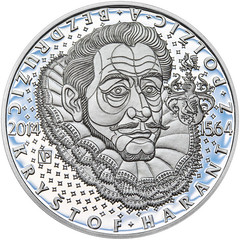
Inner- (left) and Outer-orientation (right)

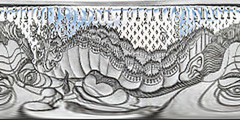
Transformed images with the legends straightened out
Getting back to the ORIENTATION of legends, here's what Bruce Smith originally asked:
When a coin or medal has an inscription running in the border or near the edge of the flan, the bottoms of all the letters may point inward, OR they may point outward, OR the top inscription may have the letters pointing inward and the bottom inscription will have the letters pointing outward. Is there a term for these different orientations?
To which I later wrote:
Maybe it's time to invent proper terms. A bellybutton is either an innie or an outie. Maybe those could be the shorthand terms for non-linear (not in a straight line) legend orientations, such as inner-, outer- and mixed-orientation text legends. Any thoughts or suggestions? Below are reference images of coins with inner- and outer- orientations from the earlier article. -Editor
In an email response titled "Legendermania", Harry Waterson writes:
I have been waiting with 'copy and paste' just strokes away to learn the proper way to describe the letter orientation of a legend on a coin or medal. It seems to me there must be some shorthand in the medal striking community to describe an 'innie' or an 'outie.'
To keep the topic alive and having given it a thunk, here are some thoughts;
- Almost all legends are capitalized. (Only Paul Manship did some legends and inscriptions in upper and lower case that I can remember)
- Almost all legends have double orientation to make the upper legend and the lower legend readable without spinning the medal. Mostly these legends are separate thoughts and lend themselves to this orientational diversity.
So let's dip into typography and remembering that we are usually dealing with caps, i want to call the normal, common legend "upper and lower caps" or abbreviate it to
U/L Caps.
U Caps = Upper legend only
L Caps = Lower legend only
Legends with an inner or outer orientation usually go full-circle around the medal and represent one continuous thought. So by extension these could be described as U-Caps or L-Caps.
To further reduce the abbreviation to catalog speak: Leg.(U/L) or Leg.(UC) or Leg.(LC) or Leg (U-C) or Leg (L-C) Of course the explanation of all this in the front of the catalog would probably take up more space than just dealing with the issue on a case by case basis. Upper or lower.
Or there is the clock face option. A normal legend could be described as 9-3 over 8-4. An U-Cap legend could be 12369. an L-Cap could be 12369 (italics to indicate an L-Cap). Using the clock face has the added advantage of telling the reader where normal two parts of a legend start and end. And where a continuous legend starts. For the Latin classicist this system could be transliterated from Arabic to Roman numerals. Greek classicists are on their own. Gen-Xers who get their time digitally might find this option daunting.
Then there is the NorthSouthEastWest (GPS) convention. NS is the normal, common, garden variety legend combo. NESW is the full circle legend with top-of-letters out and conversely NWSE is top-of-letter in. This would probably work better at a bridge table. NEWS would mean West has gone out of turn. Or just a News Flash that the dummy couldn't count..
How about a little symbolism. Just pick a symbol and assign a format, i.e.
Spades Hearts Diamonds Clubs
?. Upper legend only
? Lower legend only
?&? Normal U/L Caps legends
? Outie.
? Innie.
Anybody feeling flush yet?
I could go on all day
It's fun to wander through
Some symbol stuff with you
And tell you what they mean to me.
To read Kavan's article, see:
Ruhuna - Lanka Lead - Inscribed
Brahmi (coins.lakdiva.org/ruhuna1/lakshmipbtoken.html)
To read the earlier E-Sylum article, see:
OCR AND NON-LINEAR LEGEND ORIENTATIONS
(www.coinbooks.org/esylum_v17n39a20.html)
2012 OLYMPIC GOLD MEDAL COMES TO MARKET
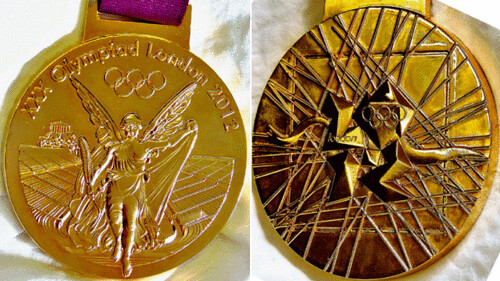
A "howlingly rare" Olympic gold medal anonymously donated to a charity auction is likely to have belonged to an official, the organiser has said.
David James, of James & Sons Auctioneers, in Fakenham, Norfolk, said the medal was left in an envelope at a valuation event in Stowmarket, Suffolk.
But the 2012 medal, one of 4,700 made by the Royal Mint, has no inscription, unlike those given to winners.
Mr James said he had been told some "may have been given to the committee".
The medal was dropped off at the counter of a valuation day, in an envelope with the initials of the Royal British Legion written on it, earlier this month.
"As an auctioneer, I was keen to find out the provenance and after speaking to the Royal Mint I've found out that there may have been a small amount given to the Olympic committee.
"It is definitely genuine. It's howlingly rare so it's almost impossible to value. I hope it will make a lot of money."
A spokeswoman from the Royal Mint said it was contracted to manufacture medals for the London 2012 Olympic and Paralympic Games but not all were engraved.
To read the complete article, see:
London 2012 Olympic gold medal is
'howlingly rare' (www.bbc.com/news/uk-england-norfolk-29360899)
THE MARKET FOR OLYMPIC MEDALS
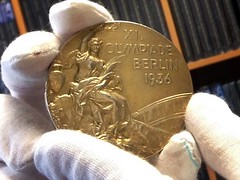 A winning performance is not the only means to an
Olympic gold medal.
A winning performance is not the only means to an
Olympic gold medal.
Sometimes it only takes a winning bid.
Gold, silver and bronze Olympic winners' medals pop up regularly in auctions around the world and occasionally on eBay. Collectors compete as avidly for them as sprinters in the 100-meter dash final.
Medals are also sold privately, sometimes before the Olympic flame goes out.
"People will tell you, 'There's no way you'll ever get one of them,'" said Don Bigsby, president of the Olympin Collectors Club. "When you're a collector, that's what sets you in motion to try to get them."
On Thursday, 14 Olympic medals go on the block in a live sale conducted by RR Auction in Boston. Another 40 medals, including 17 that were not awarded, are part of the Ingrid O'Neil mail bid auction ending Oct. 4. The next 17 days offer the greatest number of Olympic medals for public consumption with the exception of the Games themselves.
"It's the thrill," O'Neil said. "People would like to be a winner, they would like to participate, but they never can. So their next best thing is they own one of these medals."
While athletes sacrifice blood, sweat and years for a medal, the cost to purchase one is not as dear as you'd expect from recent high-profile sales.
Last December, one of the four Olympic gold medals won by Jesse Owens in 1936 was snapped up for a record $1.47 million by billionaire Ron Burkle.
A "Miracle on Ice" 1980 ice hockey gold medal awarded to Mark Wells sold for $310,700 in 2010, while a similar medal belonging to Mark Pavelich and engraved with his name went for $262,900 last May.
"Everybody who calls me and says, 'I want to sell a medal' and I give them a quote of what medals usually bring — they are totally disappointed," said O'Neil, who has auctioned Olympic memorabilia for 25 years. "They can't believe it. They think, 'OK, Jesse Owens' medal went for $1.4 million, mine should be worth at least $200,000 or $300,000.'"
Instead, O'Neil estimates that the most common bronze medal from the Summer Olympics should bring $5,000-$6,000, a silver $8,000 and a gold $10,000. In addition, gold medals have not been solid gold since 1912. They are mostly silver.
Winter Olympic medals are rarer because there are fewer athletes and events. They can range from about $10,000 to more than $30,000.
Extra medals are made in case of ties or to be given to dignitaries. Many are indistinguishable from awarded medals, though some may lack additional engraving of the event name. In O'Neil's auction, two 1932 medals are marked as souvenirs and 12 came from the studio of the 1932 designer.
O'Neil believes only 50 people around the world collect Olympic medals, half of them in the U.S.
Dick Fosbury, who won a gold medal in 1968 in the high jump, doesn't resent people who buy the same type of medal he earned.
"Most collectors really care about the objects," he said. "They are careful and understand that it's precious."
To read the complete article, see:
Olympic medals hit the market in record number
(www.usatoday.com/story/sports/olympics/2014/09/16/olympic-medals-auction-collectors/15736857/)
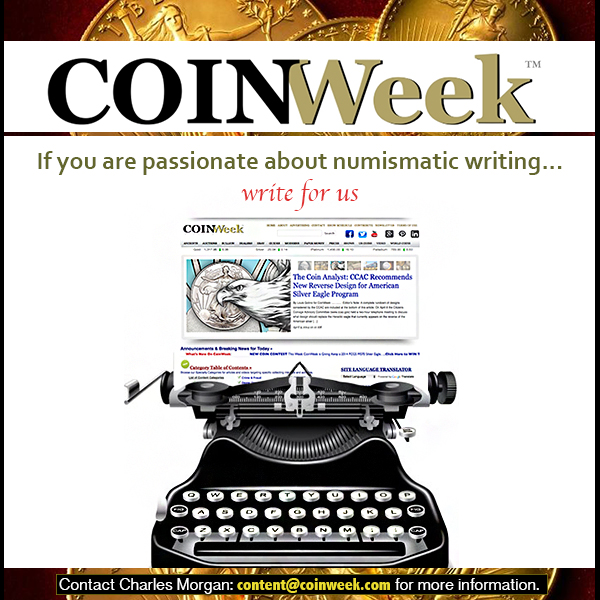
AMERICAN MEDAL OF THE YEAR NOMINATIONS
 The
American Medallic Sculpture Association Announces the First American Medal of the Year (AMY)
Award
The
American Medallic Sculpture Association Announces the First American Medal of the Year (AMY)
Award
The American Medallic Sculpture Association (AMSA) is very pleased to announce the establishment of the American Medal of the Year (AMY) Award. Mel Wacks, Head of the Planning Committee, indicates that “AMSA hopes that medalists and mints will enthusiastically participate—to help advance the appreciation of an art form that was born during the Renaissance, and that still offers collectors the opportunity to acquire and enjoy superb art medals at surprisingly affordable prices.”
Nominations for the first AMY Award are invited from medalists, mints, judges, AMSA members, or anyone else by March 1, 2015 for medals created in the United States by an American medalist in 2014. There is a limit of 3 entries per medalist per year, and once someone wins, they will not be eligible for the next 2 years.
Nomination should include name, address, email and phone number of medalist, material, size, weight, mint or foundry, maximum size of edition, actual number made, and-- if applicable--present availability, price and how to order. 300dpi color pictures of both sides, or one side if uniface, are required. Nominations for the 2014 AMY should be submitted by March 1 to amyaward2014@gmail.com.
The pleiade of distinguished jurors are: Philip Attwood, Curator of Medals, Department of Coins and Medals, British Museum and editor of The Medal; Cory Gillilland, Member of the Consultative Committee of Fédération Internationale de la Médaille d'Art and formerly Curator and Deputy Director of the National Numismatic Collection at the Smithsonian Institution; Barbara Gregory, editor of The Numismatist; Arthur Houghton, former curator of antiquities at the J. Paul Getty Museum and president of the American Numismatic Society; Steve Roach, editor of Coin World, and formerly paintings specialist at Christie's; Dr. Alan Stahl, Curator of Numismatics, Princeton University, and one of the founders of AMSA; and Ben Weiss Ph.D., medal collector and author, member of the board of directors of Medal Collectors of America and its webmaster.
Further information about AMSA, established by leading American medalists and collectors in 1982, can be found at www.amsamedals.org.
FIDEM 2014, SOFIA BULGARIA
 The 33rd FIDEM congress was held Sept 2-6 2014 with the Grand
Hotel Sofia as the main venue for the meetings and lectures, and the National Archaeological Museum
as the venue for the exhibition of 785 contemporary medals from 443 artists representing 30
countries.
The 33rd FIDEM congress was held Sept 2-6 2014 with the Grand
Hotel Sofia as the main venue for the meetings and lectures, and the National Archaeological Museum
as the venue for the exhibition of 785 contemporary medals from 443 artists representing 30
countries.
In addition to the main exhibition of medals, there were several additional exhibitions. These included a Student Medal show at the National Academy of Art, a Dutch Medal project show, and group or individual shows featuring the works of Emil Bachijski, Mirena Zlateva, Natash Ratcliffe and Bogomil Nikolov.
In the scheme of things, there were about 140 registered participants, of which some 16 were young artists participating on scholarships provided by the University Museum of Bergen. There were sixteen participating artists and members from the United States. Four gave PowerPoint lectures: George Cuhaj, Cory Gillilland, Mashiko and Ira Rezak.
In addition to the lectures, there was a tour of the Art School studio and foundry; a walking tour of historic Sofia, and a day trip to the historic town of Plovdiv. A medals fair was held where participants could meet artists and see more of their works.
The official congress medal was designed by Bogomil Nikolov. It features the moon and sun on the obverse, and the congress logo on the reverse. Cast bronze, each registered participant received one.

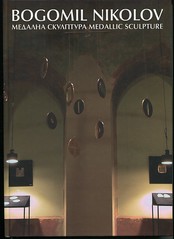
Several books were available for the various exhibitions:
The exhibition catalog is hardcover, 290 pages, color. It lists all participating artists, titles and descriptive data as well as contact information. Not every medal was illustrated, so a disc is included which has images of all medals. No ISBN number.
Bogomil Nikolov, Medallic Sculpture, is the hardcover catalog of his works, and lists 414 of his works, many illustrated in color. Pages are unnumbered, and it is big. No ISBN number.
The Dutch Medal exhibition project included a stitched bound catalog, EEN BEELD VAN EEN PENNING. At 96 pages, it was as creatively done as the exhibition, which featured medals in a display format for visitors to interact with them - touch them. Many were hung (via natural holes in the medals, by rope or wire, in display groups). ISBN 978-90-9028331-9.
This was the first time that the congress registration and activities was organized by a third-party service, the Company for International Congresses, who were selling extra catalogs or medals. If interested in the official catalog, try contacting them at sofiafidem2014.@cic.bg
The next congress will be held the first week of September 2016 in Belgium.
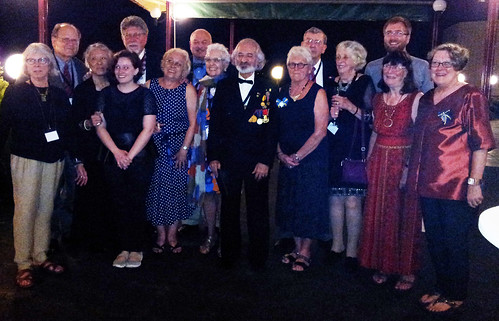
The American Delegation to the 2014 FIDM Congress
L-R: Polly Purvis, Ira Rezak, Mashiko, Lindsay Nonhof-Fisher, James MaloneBeach, Ivanka Mincheva, George Cuhaj, Marie Jean Lederman, Amanullah Haiderzad, Carole Howard, Thomas Gillilland, Cory Gillilland, Anne-Lise Deering, Anthony Nonhoff-Fisher, Leeny MaloneBeach. Camera shy: Eileen Cuhaj.
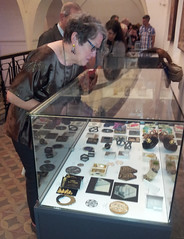
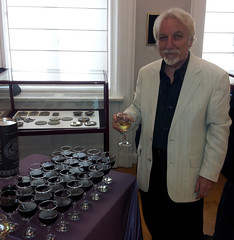
ABOVE: Leeny MaloneBeach takes a closer look at the display in the National Archaeological Museum, and Bogomil Nikolov, the guiding force of Bulgarian Medalists, and the congress
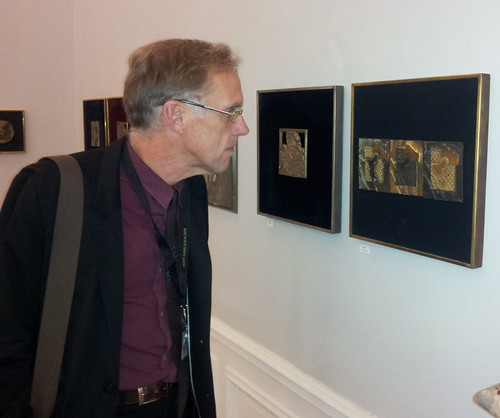
Philip Attwood, Keeper of Coins and Medals at the British Museum and FIDEM president looks over part of the Bogomil exhibition
For more information, see:
www.fidem-medals.org
THE MUSEUM OF AMERICAN FINANCE
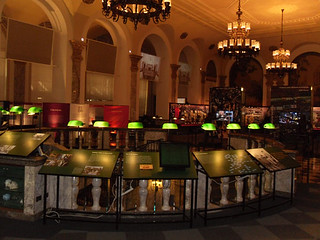 On a recent visit to the Big Apple, I
wanted to have another look at this very small street I myself once spent so much time on. Wall
Street has so much say as to the state of the world’s economic activity that with one ill-conceived
or inaccurate rumor, it can all come tumbling down in a “New York second”. For me or any visitor to
the financial district, what better place to start this quest & discover what makes the place
tick than the Museum of American Finance (MoAF).
On a recent visit to the Big Apple, I
wanted to have another look at this very small street I myself once spent so much time on. Wall
Street has so much say as to the state of the world’s economic activity that with one ill-conceived
or inaccurate rumor, it can all come tumbling down in a “New York second”. For me or any visitor to
the financial district, what better place to start this quest & discover what makes the place
tick than the Museum of American Finance (MoAF).
The MoAF is housed in the old Bank of New York building which is in itself, a splendid architectural treasure with its sumptuous & stately interior. A series of murals chronicling the emergence of New York as a financial powerhouse were commissioned when the Building first opened and were carefully restored. I had an opportunity to speak with Becky Laughner, Director of Exhibits & Archives who kindly guided me through the many points of interest and explained the very impressive presence of Alexander Hamilton, the first American Secretary of the Treasury who was also the founder of the Bank of New York in 1784. As New York is a popular destination for many world travelers, I highly recommend a visit to the MoAF, especially if your interests follow the world of finance, in a city of hustle & bustle, it’s an oasis of peace and tranquility and… you might just learn something you didn’t know before about just what makes the world go round!
Michael Alexander: The Museum of American Finance has a very interesting beginning and was founded during one of the most tumultuous times in the financial world, can you tell our readers how and when the MoAF was founded and most of all why..?
Becky Laughner: The Museum of American Finance was founded by John Herzog in response to the Crash of 1987. A collector of historical financial documents working in the financial services industry, Herzog experienced the crisis firsthand. He founded the Museum to provide historical context for the financial markets, which he realized the country lacked. Today the Museum welcomes more than 47,000 visitors annually and partners with many non-profit financial literacy organizations, as well as other finance museums around the world through the International Federation of Financial Museums (IFFM), which the Museum co-founded in 2013.
MA: The previous location was quite close to the World Trade Center – how was the MoAF affected in the aftermath of 9/11 and were the events on that day a facilitator for the MoAF to relocate..?
BL: Located at 26 Broadway, MoAF was the closest museum to Ground Zero and, as such, was forced to close for several months after 9/11. Macy’s department store generously offered exhibition space in their Herald Square display windows during the holiday season, so the Museum was able to maintain a physical presence in New York City while Lower Manhattan was inaccessible. Prior to the attacks, the Museum’s board had begun looking for a larger space, but it became a more pressing need after 9/11, especially as the New York Stock Exchange closed its Visitor Center and Wall Street tourists had nowhere to go to learn about the financial markets.

MA: I found the display of early American banknotes especially interesting as there are some very rare items included, especially the banknotes issued by private banks before the formation of the Federal Reserve, but which items in particular are perhaps unique to the MoAF or of special interest in this collection..?
BL: The Museum’s “Money: A History” gallery covers the history of American currency from Native American wampum to the most recent designs of the seven denominations of Federal Reserve Notes in circulation today. Some of the more rare and interesting notes include a beautifully engraved silver certificate of the 1896 series (also known as the Education Series), depicting allegorical figures of “History Instructing Youth.” Also on display are North African and Hawaii Emergency currency issued during World War II to circulate in those territories so that they could easily be identified and voided if they fell into enemy hands. The Hawaii note has the word “HAWAII” overprinted on both sides. The North Africa note is a silver certificate with a unique yellow Treasury seal. Although only a handful are on display in “Money: A History,” the Museum has a significant collection of early American colonial and continental currency. One of my favorite items in the currency collection is a Lansingburgh Museum penny, a one cent note issued in 1792 by a small library and museum in the town Lansingburgh in Rensselaer County, New York. I find the idea of museums issuing paper money very charming.
The Museum of American Finance is open from Tuesday thru Saturday, 10 am to 4 pm with free admissions for all visitors on Saturdays through 2014. For more information on planning your visit, please visit their website at: http://www.moaf.org/index
To read the complete article, see:
Interview with the Director of Exhibits & Archives at the Museum of American Finance
(news.coinupdate.com/interview-with-the-director-of-exhibits-at-the-museum-of-american-finance/)
THE BOOK BAZARRE
COAL DOLLARS

We purchased a small lot of silver dollars the other day, and there were (10) Coal Dollars. “Coal Dollars” are shrouded in mystery. They show up here in silver dollar lots, usually from long time Fairbanks families. This is the largest grouping we have seen. Based upon what he has been told, Joe Usibelli says in the early 50’s, the Jonesville Coal Co. of Jonesville, near Sutton, paid their employees with silver dollars with the “This is a Coal Dollar” sticker attached. This was to show the impact that the mine had on the local economy. I seem to recall hearing the U.S. military did the same thing with $2 bills.
Of the (10) coins, (9) had nice, complete labels. The one with the poor label is shown above. All were Peace Dollars, except the one in the middle above, which is a 1921 Morgan Dollar.
One of these sold for $61 on eBay last year. We have sold them in the past for as much as $100. Let’s price them this way: 1) Peace Dollar with complete label - $45 2) the Morgan Dollar with complete label - $55 and 3) the Peace Dollar with an incomplete label - $35. Prices are postpaid.
For more information, email Dick at:
akcoins@mosquitonet.com
MORE STICKERED COINS
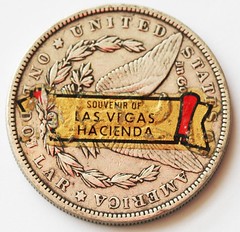
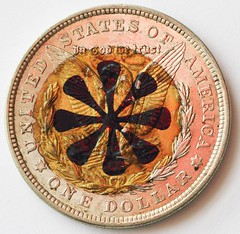
Stickered dollars
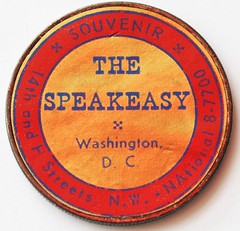
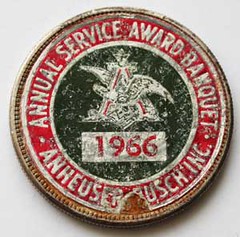
Stickered dollars

Stickered quarter
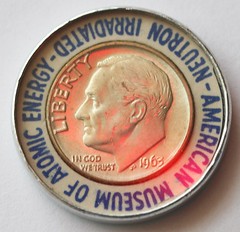
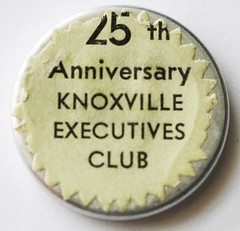
Stickered irradiated dime
SCULPTOR ANNA COLEMAN LADD
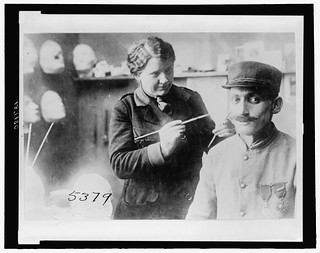 On the day after Christmas in 1920, a French mailman and
veteran of World War I wrote an American woman named Anna Coleman Ladd to thank her for what she
had done for him during the war.
On the day after Christmas in 1920, a French mailman and
veteran of World War I wrote an American woman named Anna Coleman Ladd to thank her for what she
had done for him during the war.
Ladd knew the veteran, Charles Victor, who had been wounded in the face by a hand grenade in 1915. She had two photos of him.
In one, he is sitting in a chair, wearing his uniform and military medals. He has large ears and a shock of dark hair, parted on the side. But the lower half of his face is mutilated. Most of his nose and lips are gone, and his mouth looks crooked and rearranged.
In the second photo, he is sitting in the same chair. But now he is wearing glasses and a jaunty mustache, and there is no sign of injury.
What Ladd had done for Victor was not plastic surgery.
She was a sculptor. And he was one of the scores of disfigured French and American soldiers for whom she had made exquisite metal masks to conceal their war injuries.
With the start this summer of the centennial of World War I (1914-18) and increased interest from researchers, the Smithsonian Institution’s Archives of American Art has posted a cache of Ladd’s papers online.
The collection includes letters, scrapbooks, photos and notebooks from Ladd’s long career as a sculptor. And it includes files and photos from her short but fascinating work as director of the Red Cross mask-making studio in Paris.
“She was a neoclassical sculptor,” said David Lubin, the Charlotte C. Weber professor of art at Wake Forest University.
“She was very interested in principles of ancient art, the sort of beautiful serene face,” he said. “And she gives these men .?.?. this almost unreal serenity.”
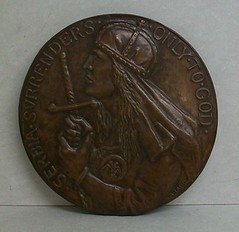 Anna Coleman Ladd (American 1878-1939): a bronze
medallion cast in low relief with a warrior of the Holy Roman Empire and reading 'Serbia
Surrenders Only To God', signed AC Ladd, 25cm diameter.
Anna Coleman Ladd (American 1878-1939): a bronze
medallion cast in low relief with a warrior of the Holy Roman Empire and reading 'Serbia
Surrenders Only To God', signed AC Ladd, 25cm diameter.
To read the complete auction lot, see:
www.batemans.com/lot.php?lot=151555
To read the complete article, see:
An American sculptor’s masks restored French soldiers disfigured in World War I
(www.washingtonpost.com/local/an-american-sculptors-masks-restored-french-soldiers-disfigured-in-world-war-i/2014/09/22/4748b8d4-38ec-11e4-9c9f-ebb47272e40e_story.html)

JEFF GARRETT ON TECHNOLOGY AND NUMISMATICS
Expedited delivery is one immediate result of improved technology. Many years ago, I employed one individual whose primary job was to ship packages each day. This person would have to carefully wrap 10-15 boxes for Registered Mail, fill out the forms by hand, and then go stand in line at the post office to ship them. Today, my office assistant can rapidly fill FedEx boxes with coins, go online to fill out the air bills, and around 4 pm a FedEx driver picks them up. This one advance in technology saved me one extra employee, and I am able to track the packages online. I also have the added peace of mind knowing the coins will arrive securely the next day.
The same productivity savings have occurred in other parts of the rare coin business, as well. At one time, producing rare coin photographs was quite the undertaking. Your company either operated a dark room or paid considerable money to have images developed off-site. Many years ago, my rare coin auction company had an in-house dark room. That room is now used for storage. Digital photography has been a huge plus for the rare coin business, and its importance cannot be overstated. Digital photography of rare coins is why the Internet is so vital to the hobby. You can now view images of thousands of rare coins for sale at any given time. The quality of good digital images has given buyers the confidence to bid online for hundreds of millions of dollars of rare coins each year. NGC makes wonderful use of digital photography. Every graded and encapsulated coin is imaged and can be viewed online. This is a great tool for anyone wanting to verify the legitimacy of an NGC-certified coin.
Nearly every successful rare coin company is now a technology company. Most have at least one or more individuals on staff at all times to solve tech issues, post coins online, create digital images, and tackle other computer-related tasks. Many successful collectors have also become more tech savvy in recent years. Quite a few can perform detailed online research, including locating coins and establishing values. A few years ago, I taught a class at the ANA Summer Seminar on rare coin pricing. Much of the class involved how to properly use online tools available to collectors.
To read the complete article, see:
Technology and
Numismatics (www.coinweek.com/education/numismatic-tech/technology-numismatics/)
ARTICLE PROFILES WILL NIPPER
 Will Nipper of Conway can’t remember a time he was not interested
in collecting coins.
Will Nipper of Conway can’t remember a time he was not interested
in collecting coins.
“I guess I was about 5,” he said when asked how long he has been a numismatist (coin collector). “I’ve been collecting over a 50-year period.”
Nipper, 55, is especially interested in the coins from the Colonial period of American history.
“There are about 600 [people] or so who collect from this period,” he said. “We’re a pretty limited bunch.”
Nipper has been chosen to receive an award from the Colonial Coin Collectors Club (C4) for his book In Yankee Doodle’s Pocket: The Myth, Magic and Politics of Money in Early America. He will receive the C4 Book Award, which is a silver medal, during the organization’s 20th annual convention Oct. 30 in Baltimore, Maryland.
The convention is being held in conjunction with the Coinage of the Americas Conference, which is jointly sponsored by C4 and the American Numismatic Society. Nipper, who helped organize C4 in 1993, said both groups are national membership organizations that promote study and appreciation of numismatic history.
Nipper said he definitely plans to attend the convention.
“It’s usually held in Boston, but it will be in Baltimore this year,” he said. “I haven’t missed a convention yet.”
Nipper said he took 10 years to write the 576-page hardback book, which he published himself in 2008 through Bowmanstone Press Inc.
“I wanted to leave a legacy for my kids,” he said.
Nipper and his wife, Debbie, have four daughters: Kelsey, Shelby and Abby, who are all in college, and Brinley, who is in the first grade.
“They don’t understand why Dad loves coins so much,” he said with a smile. “I don’t remember when I wasn’t interested. But it’s always been about the history and never the investment.”
“It is my thesis that if you look at the coins, the paper money, the trade items for the last 250 years dating back to the late 1570s, you can track the emergence of the American nation,” he said. “My book is the story of America as told through the institution of commerce. It is a history book illustrated with money.”
The oldest coin Nipper has is a Massachusetts silver coin that dates to the 1650s.
“It was the first one made in America,” he said. He has a 1652 pine-tree shilling as well.
Nipper also has a 1776 Continental dollar, which he said was designed by Benjamin Franklin. It was made of pewter, and the imprinted mottoes read “fugio,” which Nipper said is short for “tempus fugit” or “time is fleeting,” and “mind your business.”
He said the meaning of these mottos could be interpreted as “Time is getting away. Get to work minding your commerce.”
Nipper’s collection of Colonial American currency includes coins that were made through 1840, which he said was the beginning of America’s Industrial Age.
“That’s when I stopped,” he said. “The U.S. Mint opened in 1793, and by 1840, with the [invention of] steam presses, it was finally able to catch up with public demand. Before then, all of the coins were handcrafted.”
Nipper grew up in Beebe. He graduated from Beebe High School in 1977 and from the University of Central Arkansas in Conway in 1982 with a Bachelor of Science degree in mathematics and computer science, and minors in physics and history.
In addition to his affiliation with the Colonial Coin Collectors Club, Nipper is also a member of the Central Arkansas Coin Club, which meets at 6:15 p.m. the third Thursday of each month at Parkway Place Baptist Church, 303 Parkway in west Little Rock.
For more information on Nipper and his book In Yankee Doodle’s Pocket, call him at (501) 514-0785 or visit www.bowmanstonepress.com. The book is also available at www.amazon.com.
To read the complete article, see:
Conway coin collector, author to be honored at convention
(www.arkansasonline.com/news/2014/sep/25/conway-coin-collector-author-be-honored-convention/)
ARTICLE PROFILES RICHARD BAGG
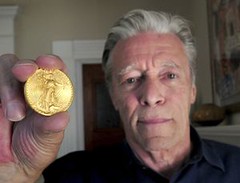 Have you checked your portfolio of rare coins lately? Richard Bagg
follows the field closely, because he is immersed in this esoteric endeavor.
Have you checked your portfolio of rare coins lately? Richard Bagg
follows the field closely, because he is immersed in this esoteric endeavor.
In an era of Fidelity, Putnam and Charles Schwab, the Newburyport expert and consultant is deeply involved in a science — and investment field — almost as old as the republic itself.
“Many people start as coin collections, with pennies, nickels and dimes as youngsters,” said Bagg, who has close to four decades of experience.
“I continued my interest over the years and have been a rare coin specialist to investment professionals, financial planners and actual investors.”
Bagg, a native of western Massachusetts, earned a doctorate in psychology from the University of New Hampshire.
But he gravitated to coin collecting and consulting, which has emerged as an investment against inflation and falling stock markets.
One of his specialties is appraising collections for estates, museums, libraries and historical institutions such as the Historical Society of Old Newbury.
Another area of his expertise is auction. He is a past auction director for one of the foremost auction firms in the business, Bowers and Merena.
During his time there, he acquired consignments for more than 150 auctions, and played a role in the offering of collections from such institutions as the New York Public Library and Johns Hopkins University.
“A lot goes into coin collecting, including knowledge of history and an awareness of the market,” said Bagg, who travels frequently to appraise and/or plan sales of collections.
“I have participated in the production of 150 coin auctions for more than 10,000 clients,” the Temple Street resident said.
To read the complete article, see:
Check
your coin jar
(www.newburyportnews.com/news/local_news/article_a2971dfd-e766-5ed2-a350-e6ca27631dfc.html)
THE BOOK BAZARRE
LORD ASHCROFT BUYS SGT. MAJOR GARVIN MEDALS
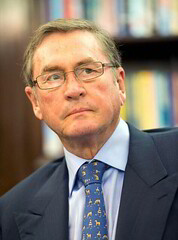 Lord Ashcroft bought the medal, awarded to Sergeant Major
Stephen Garvin in 1857, for £228,000, from London auction house Dix Noonan Webb.
Lord Ashcroft bought the medal, awarded to Sergeant Major
Stephen Garvin in 1857, for £228,000, from London auction house Dix Noonan Webb.
Sergeant Major Garvin is considered one of the Victorian era's greatest heroes for his daring antics in colonial India during the bitter year-long fight for independence in 1857.
He led 12 men on a brave assault on a stronghold of Indian Sepoy soldiers and, against all odds, either killed or captured all of the enemy troops.
He was presented with the VC - the highest award for valuer - by Queen Victoria herself and was also one of only a dozen men to be presented with a Distinguished Conduct Medal during the conflict.
His medal set was described by experts selling it as "unique" and had been expected to sell at auction for £140,000.
But after a bidding war erupted the hammer price was £190,000, which shot up to £228,000 with the buyer's commission added.
The medal set also includes the Punjab Medal 1848-49 with clasps Mooltan and Goojerat, the India General Service Medal 1854-95 with clasp North West Frontier, the Indian Mutiny Medal with clasp Delhi and the Army Long Service and Good Conduct Medal.
The honours made Garvin the most highly decorated non-commissioned soldier of the Indian Mutiny.
David Erskine-Hill, medals specialist at Dix Noonan Webb, said: "Garvin's decision to volunteer for the storming party was remarkable given that his chances of surviving the attack were not high.
"His bravery then and when he later also won the Distinguished Conduct Medal made him one of Victorian Britain's greatest heroes."
To read the complete article, see:
Victoria Cross and other medals sold to Tory peer for more than the price of a house
(www.express.co.uk/news/uk/513890/Victoria-Cross-and-other-medals-sold-to-Tory-peer-for-more-than-the-price-of-a-house)
To read an earlier E-Sylum article, see:
LORD ASHCROFT'S VICTORIA CROSS
COLLECTION GOES TO IMPERIAL WAR MUSEUM (www.coinbooks.org/esylum_v11n28a17.html)
ARTICLE PROFILES “THE EMPEROR OF THESE UNITED STATES”

When the going gets tough, the tough declare themselves Emperor. Or so it seems for Joshua Abraham Norton, who on September 17, 1859, published the following declaration in the San Francisco Evening Bulletin:
“At the peremptory request and desire of a large majority of citizens of these United States, I, Joshua Norton, formerly of Algoa Bay, Cape of Good Hope, and now for the last nine years and ten months past of San Francisco, California, declare and proclaim myself the Emperor of these United States.”
Norton was born in London in 1818, but lived from babyhood through his late twenties in Cape Town, South Africa. By 1849, when he learned of the discovery of gold in California, he was already in business for himself and had received a comfortable inheritance from his parents. By November of that year (in time to be a true Forty-Niner) he had arrived in San Francisco and quickly made somewhat of a success of himself as a commission merchant. He bought real estate, operated the first cigar factory, and opened the first rice mill in the city. An unsuccessful attempt to corner the market on rice, as well as downturns in the local economy led him to bankruptcy (and very possibly dementia) in 1858, less than a decade after his arrival in the city.
However, it was only a year later that Norton reappeared on the scene in his new role as imperial leader, becoming a prime tourist attraction and generally endearing himself to residents of and visitors to San Francisco. He issued regular pronouncements and decrees calling for, among other things, abolishing the Congress of the United States, by force of the U.S. Army if necessary. As Emperor, he issued paper money “bonds” in denominations from 50¢ to $100, which he used as currency (generally accepted) in the local economy.
After 20 years, on January 8, 1880, Emperor Norton’s reign came to an end when he collapsed on a downtown San Francisco corner. His obituary was printed on the front pages of local newspapers and it is said that over 30,000 people attended his funeral.
While most of the “bonds” issued by Emperor Norton are long gone, it is believed that 25 to 35 remain in collectors’ hands. It is a rare occasion when we offer one for sale, however we do note that we offered the three examples shown here in a single sale. That was the John J. Ford, Jr. Collection, Part XX, which we sold in October 2007.
To read the complete article, see:
“The Emperor of these United States” (www.stacksbowers.com/NewsMedia/Blogs/TabId/780/ArtMID/
2678/ArticleID/64757/%E2%80%9CThe-Emperor-of-these
-United-States%E2%80%9D.aspx)

THE COINS OF ANCIENT SPARTA
Hundreds of different Greek cities issued coins between the birth of coined money around 650 BCE and the end of Greek civic coinage some time after 300 CE. The apparent exception was Sparta.
Many serious collectors of ancients have never seen a Spartan coin. Some believe Sparta struck no coins at all. As usual in Classical Numismatics, however, there is a “Yes, but...” lurking in the weeds. Sparta issued coins, in small quantities, well after it had ceased to be a major power in the affairs of the Greek world.
While other Greeks experimented with exotic political innovations like democracy, oligarchy and tyranny, conservative Sparta clung stubbornly to its archaic dual monarchy: two equal kings from different dynastic families, the Agiads and the Eurypontids. It made sense to have a spare king on hand, considering the high risk that at least one king in every generation would die in battle.
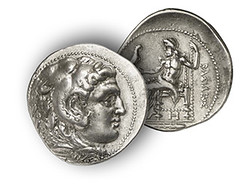 Areus, a member of the Agiad dynasty who ruled from 309
to 265 BCE, was the first Spartan king to issue coins in his own name. This break with tradition
was driven by the need to pay mercenaries in his war against Macedonia, Sparta no longer having the
manpower to raise a citizen army. Ironically, Areus’s silver tetradrachm was closely modeled on the
widely circulating Macedonian coinage of Alexander, with the head of Herakles on the obverse and an
image of Zeus enthroned holding an eagle on the reverse. Only the inscription “King Areus”
indicates the source. Just four examples of this remarkable coin are known, three in museums.
Areus, a member of the Agiad dynasty who ruled from 309
to 265 BCE, was the first Spartan king to issue coins in his own name. This break with tradition
was driven by the need to pay mercenaries in his war against Macedonia, Sparta no longer having the
manpower to raise a citizen army. Ironically, Areus’s silver tetradrachm was closely modeled on the
widely circulating Macedonian coinage of Alexander, with the head of Herakles on the obverse and an
image of Zeus enthroned holding an eagle on the reverse. Only the inscription “King Areus”
indicates the source. Just four examples of this remarkable coin are known, three in museums.
Areus also issued rare silver obols, suggesting a need for small change. Fighting the Macedonians outside Corinth, Areus was killed in 265 BCE.
 Cleomenes (ruled 235-222 BCE) placed a realistic
portrait of himself wearing the diadem (a golden headband that symbolized Hellenistic monarchy) on
his silver tetradrachms. On the reverse, along with the abbreviation Lambda-Alpha (for Lakedaimon,
the name Spartans gave their territory) was the image of Orthia, an ancient local nature goddess
identified with Artemis, sister of Apollo and goddess of hunting.
Cleomenes (ruled 235-222 BCE) placed a realistic
portrait of himself wearing the diadem (a golden headband that symbolized Hellenistic monarchy) on
his silver tetradrachms. On the reverse, along with the abbreviation Lambda-Alpha (for Lakedaimon,
the name Spartans gave their territory) was the image of Orthia, an ancient local nature goddess
identified with Artemis, sister of Apollo and goddess of hunting.
Cleomenes also issued anonymous bronze coins. This suggests that Sparta’s domestic economy had evolved to function more like other Greek cities, with a need for small change in daily life.
To read the complete article, see:
Ancient Coins: What about
Sparta? (www.coinweek.com/featured-news/ancient-coins-sparta/)
THE SEATON DOWN HOARD OF 22,000 ROMAN COINS
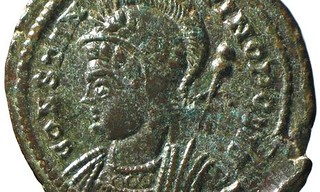 One of the largest hoards of Roman coins ever discovered in the UK has been unearthed by a
builder.
One of the largest hoards of Roman coins ever discovered in the UK has been unearthed by a
builder.
Metal detector enthusiast Laurence Egerton discovered the haul of 22,000 fourth-century copper-alloy coins in Devon in November last year.
After uncovering the coins on the Clinton Devon Estates, near Seaton Down, Egerton reported the find to the landowner and the local authority – and slept in his car for three nights to guard it.
The hoard was then carefully removed in its entirety by a team of archaeologists. Over the past 10 months the coins have been lightly cleaned, identified and catalogued by experts from the British Museum.
The Seaton Down hoard, which includes coins that are very well preserved, has been declared treasure by a coroner.
The Royal Albert Memorial Museum in Exeter is now launching a bid to purchase the coins for public display in the city.
Egerton spoke of his shock at finding the haul, which was located near a Roman villa and possible fort at the Honeyditches site.
“Initially I found two small coins the size of a thumbnail sitting on top of the ground and then, as I began working in a grid formation in the surrounding area I had a 50-50 signal on the metal detector, which means that there is probably iron involved,” he said.
“Most detectors are set up to ignore iron but I decided to dig the earth at that spot and immediately reached some iron ingots which were laid directly on top of the coins.
“The next shovel was full of coins – they just spilled out over the field. “I had no idea how far down the coins went so I stopped immediately and phoned my wife to come to the site with a camera.
“Under the terms of my licence, I contacted Clinton Devon Estates and Devon county council and was instructed to take away what was loose and then fill in the hole.
Most of the coins are associated with Constantine I and his family, who became emperor while in Britain in AD306.
Other coins date from the joint reign of Constantius II and his younger brother Constans, from AD337 to 40.
Dr Roger Bland, from the British Museum, said: “It is one of the largest coin hoards of the fourth century ever found within the Roman empire but, despite the number of coins found, the financial value would not have been great, amounting to approximately four gold coins.
To read the complete article, see:
Roman coin
hoard, one of the largest found in UK, unearthed by builder
(www.theguardian.com/uk-news/2014/sep/26/roman-coin-hoard-clinton-devon-estates)
The “Seaton Down Hoard” of copper-alloy coins is one of the largest and best preserved 4th-century collections to have been found in Britain. It pales in comparison only with the 52,500 coins discovered by a hospital chef, also using a metal detector, in Frome, Somerset, in 2010.
Bill Horner, an archaeologist at Devon county council, said: “The coins were in remarkably good condition. Coming out of the ground, you could see the portrait faces, a family tree of the House of Constantine.” The hoard was found near an excavated Roman villa in Honeyditches last November. Experts believe that the coins were buried by a soldier for safe keeping.
The collection was announced yesterday at the British Museum, in London, which is displaying the coins alongside other artefacts recovered since the 1997 Portable Antiquities Scheme (PAS) was launched.
The coins bring the number of items handed over to the PAS to one million. The scheme was devised on the back of the Treasury Act 1996, which made it an offence to keep discoveries a secret. Under the law, anyone who finds an artefact must report it to their local coroner within two weeks.
The PAS allows members of the public, in particular people who use metal detectors, to report finds to their local council, which then passes details to the scheme so that it can decide whether the items are of historic importance.
To read the complete article, see:
Treasure hunter stakes out hoard of Roman coins
(www.thetimes.co.uk/tto/news/uk/article4218977.ece?shareToken=aeadb50d37d9895283d78c2f5597e8f3)
GRASPABLE TESTIMONIES: GNADENPFENNIGE
On 16 October, 2014, Gorny & Mosch will auction off the collection of Werner Jaggi (1927-2002) in Munich with auction sale #226. Over the course of several decades, the distinguished expert on religious art mainly of the Alpine region assembled the largest collection of numismatic testimonies on religious beliefs and customs the market has ever seen. After the natural sciences have explained the world to us, we have lost the understanding of the unconditional belief that is expressed in these objects. Hence, only few people can still appreciate what a gnadenpfennig or an amulet may have meant to its wearer back then.
Way into the 19th century, all people – craftsmen, peasants and noblemen alike – had felt victim to an unpredictable fate. Life could have been cut short at every second. A thunderstorm destroyed the crop and caused famines. A plague cost the life of the entire family. Help could only be expected from divine entities, security could only be achieved in the Netherworld. The human being was both powerless and defenseless. Naturally, the distressed one looked for a way to do something in this state of emergency. He went on a pilgrimage or pledged a holy trip, a financial donation, in order to have his share in the blessing – and this, by the way, is something not only the Catholics did.
When we today are faced with ‘pilgrimage’ as a term, then the important medieval pilgrimage destinations spring to mind: Jerusalem, Santiago, and Rome. Central to the people in Baroque times, though, were local pilgrimage destinations that were systematically enlarged by the leading figures of the Counter Reformation. Instead of a huge, one of a kind experience, which only a small elite circle amongst the believers could afford, a comprehensive infrastructure was created thanks to which it became possible for the ordinary believer, too, to enjoy a little religious timeout, at some instances a couple of times per year.
Another kind of source for this chapter of our cultural history are pendants, amulets, crosses and so on, as they are available for sale as memento and talisman in front of the pilgrimage church in many countries.
These ‘gnadenpfennige’ were produced in large quantities. They were often consecrated explicitly in the context of the service and hence ‘activated’, as it were. Most of them feature the cult image of the pilgrimage. Thanks to their accurate depictions they can be taken as magnificent testimonies to local history. Their illustrations provide insight into particular religious notions, myths and legends and thus into a past which is seldom referred to in the non-churchly historical narrative. The sub-form of the religious medal became wearable thanks to a loop or a punched hole. And these items definitely were being worn, sometimes around the neck, but much more often being sewed onto the hat or the clothes. They simultaneously served as visible proof of the piety of its wearer to the public eye and the believer’s self-assurance of the divine powers.
The Werner Jaggi Collection comprises mainly European gnadenpfennige from four centuries. They were consecrated to a very special saint or refer to a certain pilgrimage. In addition, they mirror how animated both piety and veneration of saints were in the Catholic territories in the post-Reformation era which provided the people with support and guidance in their life before the Enlightenment ushered in the modern era.
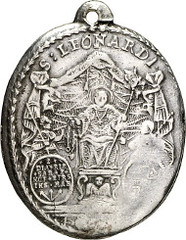
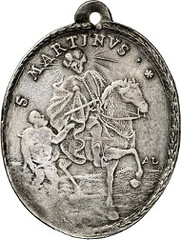
St. Leonard of Noblat. Silver pendant
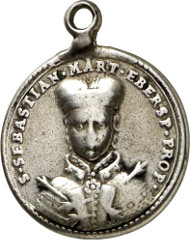
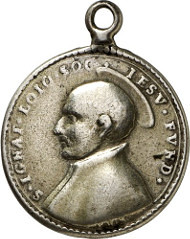
Ebersberg, Cloister Church of St. Sebastian. Cast silver pendant
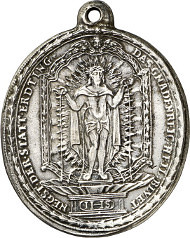

Erding. Pilgrimage Church Holy Blood. Silver pendant
To read the complete article, see:
Graspable Testimonies – Testimonies to Piety from Another Time: Part 1
(coinsweekly.com/en/Graspable-Testimonies--Testimonies-to-Piety-from-Another-Time-Part-1/8?&id=440&type=a)
THE MARSHALL COLLECTION OF CONDER TOKENS

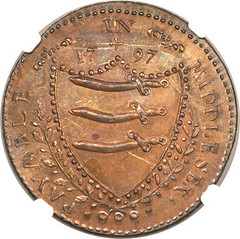
Marshall Collection of Conder Tokens launches new auction series at Heritage Auctions
A rare, 1797 Swan Penny Token, considered the finest known to exist, highlights The Marshall Collection of Conder Tokens Part I - the first of a new series of special monthly world coin auctions set to debut Oct. 2, 2014 at Heritage Auctions. The new venue seeks to elevate advanced or specialty collections with customized marketing plans and single session auctions offered through HA.com.
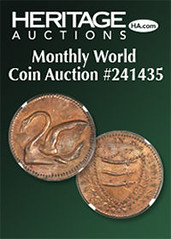 "The Marshall Collection is very advanced in this specialty area of collecting," said
Matt Orsini, Consignment Director of World Coins at Heritage. "This new series of special
monthly auctions is the perfect venue for specialized collections like this. We look forward to
showing other collectors how they can take advantage of this venue and have their coins marketed
and sold as single-collection auctions."
"The Marshall Collection is very advanced in this specialty area of collecting," said
Matt Orsini, Consignment Director of World Coins at Heritage. "This new series of special
monthly auctions is the perfect venue for specialized collections like this. We look forward to
showing other collectors how they can take advantage of this venue and have their coins marketed
and sold as single-collection auctions."
The Marshall Collection is one of the finest Conder token collections in the world in terms of size and the number of rarities it contains. Conder tokens, aka 18th Century Provincial Tokens, are a collectible form of privately-minted coinage struck in the 18th and early 19th century England, Scotland, Ireland, Wales and Anglesey. They have long appealed to collectors because of the diverse and imaginative themes ranging from historical figures, satirical, maritime, wildlife, architectural, regional and more.
The 1797 Swan Penny Token is an extremely rare token that is perhaps the finest known of its type. The specimen's sharp design elements and a sublime mixture of multicolored tone atop glossy surfaces make it one of the most highly sought issues in the Middlesex series. It appears with a $1,500 estimate.
Additional highlights in The Marshall Collection include an 1800 Leicestershire Elmsthorpe 1/2 Penny, a key issue within the Conder Token series (est. $1,000+); a 1789 Hampshire Basingstoke copper Shilling Token (est. $400+); and a 1797 Hampshire Portsmouth 1/2 Penny Token, one of six to 10 known to exist (est. $800+).
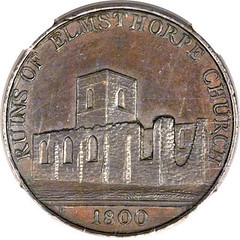
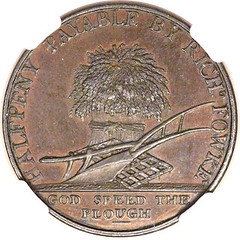
Leicestershire. Elmsthorpe 1/2 Penny 1800


Hampshire. Basingstoke copper Shilling Token 1789
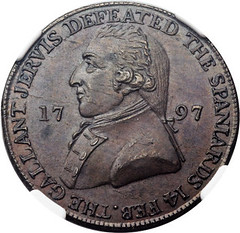

Hampshire. Portsmouth 1-2 Penny Token 1797
Following Part I, Part II of the Marshall Collection of Conder Tokens will close Oct. 30. Heritage will then offer a second collection of Conder tokens at auction in November, followed by a collection of Philippine Medals. Specialized world coin offerings are also on tap into the future, Orsini said. "Collectors with similarly specialized collections could take advantage of this venue and have their coins marketed and sold as single-collection auctions," he said.
Such collections are featured on HA.com, the largest numismatic auction site in the world, and listed as a named collection on the homepage. Opening and closing announcements are sent via email to qualified clients among Heritage's 850,000 online bidder members. Upcoming auctions in the series include The Chatham Street Collection (Sale #241445), Oct. 30 - Nov. 27, 2014, and The Dr. Rodger McFadden Collection (Sale #241449), Nov. 27- Dec. 25, 2014.
To view the sale online, see:
coins.ha.com/c/auction-home.zx?saleNo=241435

INTERMARRIAGE PROTEST ENSNARES ISRAELI BANKNOTE
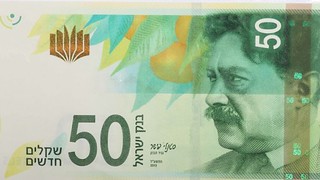 Several religious figures have criticized the Bank of Israel’s
decision to feature renowned Hebrew poet Shaul Tchernichovsky on newly minted NIS 50 notes, citing
his marriage to a Christian woman
Several religious figures have criticized the Bank of Israel’s
decision to feature renowned Hebrew poet Shaul Tchernichovsky on newly minted NIS 50 notes, citing
his marriage to a Christian woman
Dr. Hagai Ben-Artzi, brother of Prime Minister Benjamin Netanyahu’s wife Sara, said last week that the use of the Russian-born poet’s image on the bill was “an outrage.”
“Shaul Tchernichovsky has become a symbol of assimilation, of assimilation ideology,” he said, according to Israel National News. “It is inconceivable that such a person, as important a poet as he may be, should become a symbol in the state of Israel.”
Tchernichovsky was married to Russian-born Christian Melania Karlova, with whom he had a daughter, Isolda.
Ben-Artzi said he would refuse to use the new banknote, and said he hoped similar refusals by numerous other citizens would lead to its recall.
To read the complete article, see:
Tchernichovsky
sparks currency row
(www.timesofisrael.com/does-face-of-poet-who-intermarried-belong-on-new-currency/)
FEATURED WEB SITE: AMERICAN MEDALLIC SCULPTURE ASSOCIATION
This week's Featured Web Site is the American Medallic Sculpture Association.Founded in 1982, the American Medallic Sculpture Association (AMSA) works to encourage the creation, study and appreciation of the American Fine Art Medal.
All who are interested are welcome as members. Our goal is to increase awareness of medallic sculpture, to assist artists, collectors and scholars alike in their quest to share and disseminate knowledge of this “hand held” form of artistic expression.
The purpose of the American Medallic Sculpture Association (AMSA) is to encourage the creation and study of medallic sculpture in North America. All who are interested are welcome as members. Our aim is to disseminate information and add impetus in making medallic sculpture a vital and viable art form in this country.

www.amsamedals.org

